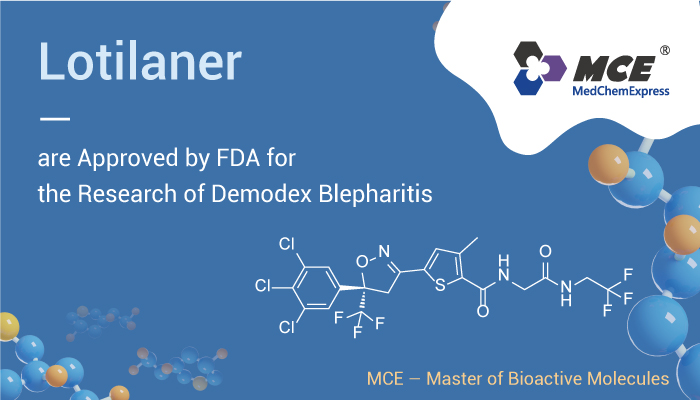GABA (γ-aminobutyric acid-gated) is the chief inhibitory neurotransmitter in the developmentally mature mammalian central nervous system. Besides, Its principal role is reducing neuronal excitability throughout the nervous system. GABACl (γ-aminobutyric acid-gated chloride channels) is a member of the Cys-loop ligand-gated ion channel (LGIC) family, together with GluCls, nAChRs and glycine receptors. Importantly, GABA receptors are first shown to be a target of organochlorine insecticides.
Demodex Blepharitis is a common inflammatory eye condition involving the skin, eyelashes, lash follicles, and sebaceous glands. Particularly, The disease is associated with infestation with Demodex mites, which are ectoparasites commonly found on human skin.

In this article, we will introduce a GABACl antagonist that has potent for the research of demodex blepharitis, Lotilaner.
Lotilaner is a parasiticide, that acts as a potent non-competitive antagonist of insects’ GABACl receptors, with an IC50 of 23.84 nM for the drosophila melanogaster GABA receptor. Besides, Lotilaner also shows inhibition for DmS-GABA, DmR2-GABA, Ls-GABA1, Rm-GABA, Cl-GABAA α1β2γ2 with IC50 values of 23.84, 38.25 52.40, 36.79, >10000 nM, respectively. Moreover, Lotilaner breaks resistance to dieldrin or fipronil.
Lotilaner also is a new oral ectoparasiticide from the isoxazoline class treatments of flea and tick infestations in dogs. Meanwhile, Lotilaner (20 mg/kg for p.o.; 3 mg/kg for i.v.) is readily absorbed, peak blood concentrations reached within 2 hours, and the terminal half-life was 30.7 days, oral bioavailability above 80% in dogs. Moreover, Lotilaner (20 mg/kg; p.o.) provides a rapid onset of flea and tick-killing activity, consistent and sustained effectiveness for at least 1 month after treatment.
All in all, Lotilaner is a potent and non-competitive GABACl antagonist, FDA approves Lotilaner for the research of Demodex blepharitis.
Reference:
[1] Rufener L, et al. Parasit Vectors. 2017 Nov 1;10(1):530.
[2] Toutain CE, et al. Parasit Vectors. 2017 Nov 1;10(1):522.